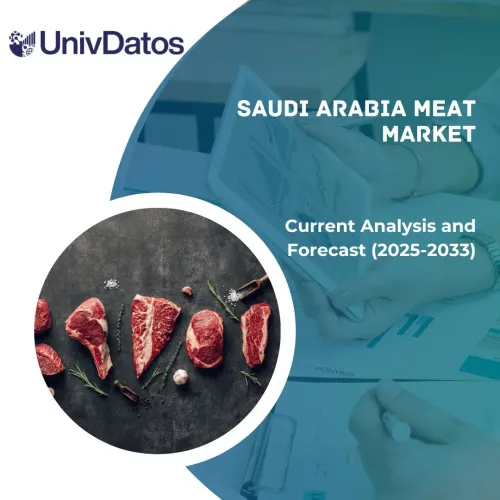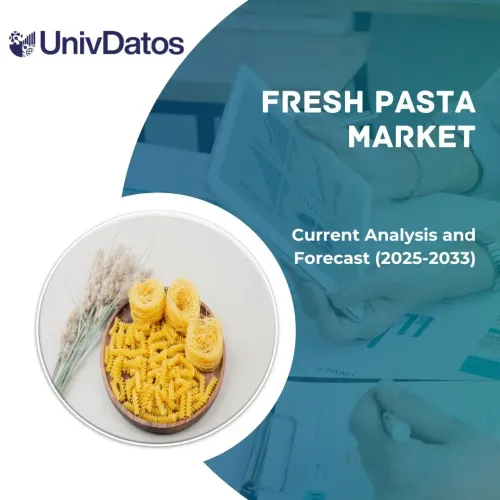- Home
- About Us
- Industry
- Services
- Reading
- Contact Us
Milk Protein Market: Current Analysis and Forecast (2021-2027)
Emphasis on Filtration Type (Milk Protein Concentrate, Milk Protein Isolate, Milk Protein Hydrolysates, Casein & Caseinates, Whey Protein Concentrate, Whey Protein Isolate, Others); Form (Dry, Liquid); Livestock (Cow, Buffalo, Goat); Nature (Organic, Conventional); Distribution Channel (Online, Offline); Application (Sports Nutrition, Infant Formula, Dairy Products, Others); and Region and Country
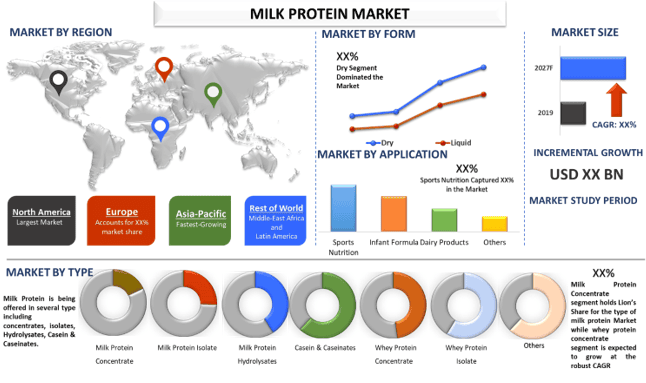
Global Milk Protein Market was valued at US$ 11 billion in 2020 and is anticipated to reach US$ 18 billion by 2027 displaying an elevated CAGR of 6% over the forecast period (2021-2027).
The growing geriatric population base with a higher predisposition to various age-related diseases such as cancer, cardiovascular diseases, arthritis, hypertension, etc. is a leading cause that is adding pace to the growth in the demand for Milk Protein for healthy diets and proper nutrition. For instance, according to the United Nations, the global population aged 60 years or over was numbered at 962 million in 2017 and is expected to reach nearly 2.1 billion by 2050
In overall spending, consumers expect to increase their purchases of both wellness products and services over the next year. We expect a greater shift toward services, especially those (such as personal training, nutritionists, and counseling) that emphasize physical and mental health. Moreover, the average American spends around $56 per month on dietary supplements. Also, The average American spends around $56 per month on dietary supplements and 3.8% of gym-goers use nutrition supplements.
The rising geriatric population coupled with gym enthusiasts in the united states is one of the prominent factors, driving the market of milk protein. U.S. Census Bureau, People aged 65 and over are expected to number 77.0 million (previously 78.0 million), while children under age 18 will number 76.5 million (previously 76.7 million) by 2034. Moreover, a rise in the number of fitness enthusiasts in the United States generating more demand for milk protein. In 2021, in the U.S., the gym industry faces a 7.2% growth rate over 2020. Also, there were 64.2 US million gym members in 2019, up 2.8% from 62.5 million in 2018, as revealed by IHRSA.
Cow Milk Production, By Region, 2019
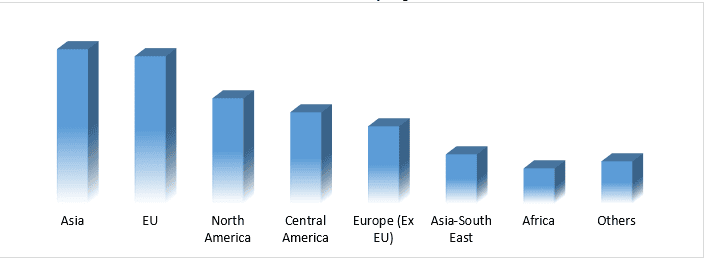
Cargill, Inc., Archer Daniels Midland (ADM), DuPont Nutrition & Health, Arla Foods, Kerry Group, Associated British Foods, Fonterra, Omega Protein, Dean Foods, Charotar Casein Company, are some of the prominent players operating in the Milk Protein market. Several M&As along with partnerships have been undertaken by these players to facilitate customers with hi-tech and innovative products.
Insights Presented in the Report
“Amongst Type, Milk Protein Concentrate segment holds the major share”
Based on the Type, the market is fragmented into Milk Protein Concentrate, Milk Protein Isolate, Milk Protein Hydrolysates, Casein & Caseinates, Whey Protein Concentrate, Whey Protein Isolate. The Milk Protein Concentrate segment grabbed major market share and dominated the market in 2020. Moreover, the segment would witness a growth of considerable CAGR during the forthcoming years. However, the Whey Protein Isolate segment would be emerging as the fastest growing sector in the forthcoming years.
“Amongst Form Type, Dry segment to dominate the market during the forecast period”
Based on the Form type, the market is fragmented into Dry and Liquid. The dry segment grabbed major market share and dominated the market in 2020. However, the Liquid segment would emerge in the forecast period and would witness a considerable CAGR during the forthcoming period.
“Amongst Livestock, Buffallo segment to dominate the market during the forecast period”
Based on the Livestock, the market is fragmented into Cow, buffalo, and Goat. The buffalo segment grabbed the major market share and dominated the market in 2020. However, the cow segment would emerge in the forecast period and would witness a considerable CAGR during the forthcoming period.
“Amongst Nature, Organic segment to dominate the market during the forecast period”
Based on the Nature type, the market is fragmented into organic and conventional. The conventional segment grabbed the major market share in 2020. However, the Organic segment would emerge in the forecast period and would witness the highest CAGR during the forthcoming period.
“Amongst Distribution Channel Type, Online segment to dominate the market during the forecast period”
Based on the distribution type, the market is fragmented into Online and Offline. The offline segment grabbed the major market share in 2020. However, the online sales segment would emerge in the forecast period and would witness the highest CAGR during the forthcoming period.
“Amongst Application, Dairy Segment segment to dominate the market during the forecast period”
Based on the Application type, the market is fragmented into sports nutrition, infant formula, dairy products, and Others. The Sports nutrition segment grabbed major market share and dominated the market in 2020. However, the dairy product segment would emerge in the forecast period and would witness a considerable CAGR during the forthcoming period.
“North America represents one of the largest markets of Milk Protein market”
For a better understanding of the market dynamics of the Milk Protein market, a detailed analysis was conducted for different regions across the globe including North America, Europe, Asia Pacific, and the Rest of the world. North America dominated the market and generated the leading revenue share in 2020 owing to the change in lifestyle and growing demand for nutrition supplements.
Reasons to buy this report:
- The study includes market sizing and forecasting analysis validated by authenticated key industry experts
- The report presents a quick review of overall industry performance at one glance
- The report covers an in-depth analysis of prominent industry peers with a primary focus on key business financials, product portfolio, expansion strategies, and recent developments
- Detailed examination of drivers, restraints, key trends, and opportunities prevailing in the industry
- The study comprehensively covers the market across different segments
- Deep dive regional level analysis of the industry
Customization Options:
The Milk Protein Market can further be customized as per the requirement or any other market segment. Besides this, UMI understands that you may have your own business needs, hence feel free to connect with us to get a report that completely suits your requirements.
Table of Content
Analyzing the historical market, estimation of the current market, and forecasting the future market of the Milk Protein Market were the three major steps undertaken to create and analyze the demand for Milk Protein across major regions. Exhaustive secondary research was conducted to collect the historical market numbers and estimate the current market size. Secondly, to validate these insights, numerous findings and assumptions were taken into consideration. Moreover, exhaustive primary interviews were also conducted, with industry experts across the value chain of the Milk Protein market. Post assumption and validation of market numbers through primary interviews, we employed a top-down/ bottom-up approach to forecast the complete market size. Thereafter, market breakdown and data triangulation methods were adopted to estimate and analyze the market size of segments and sub-segments the industry pertains to. Detailed methodology is explained below:
Analysis of Historical Market Size
Step 1: In-Depth Study of Secondary Sources:
Detailed secondary study was conducted to obtain the historical market size of the Milk Protein through company internal sources such as annual reports & financial statements, performance presentations, press releases, etc., and external sources including journals, news & articles, government publications, competitor publications, sector reports, third-party database, and other credible publications.
Step 2: Market Segmentation:
After obtaining the historical market size of the Milk Protein market, we conducted a detailed secondary analysis to gather historical market insights and share for Type, form, application, nature for major regions. Major segments included in the report are application and livestock. Further region and country-level analyses were conducted to evaluate the overall adoption of Milk Protein across the globe.
Step 3: Factor Analysis:
After acquiring the historical market size of different segments and sub-segments, we conducted a detailed factor analysis to estimate the current market size of Milk Protein. Further, we conducted factor analysis using dependent and independent variables such as Surging Cases of muscle tissue breakdown due to improper nutrition, Rising number of Gym and Fitness Enthusiasts, and Emerging Aging Population, etc., A thorough analysis was conducted for demand and supply-side scenarios considering top partnerships, merger and acquisition, business expansion, and product launches in the Milk Protein industry across the globe.
Current Market Size Estimate & Forecast
Current Market Sizing: Based on actionable insights from the above 3 steps, we arrived at the current market size, key players in the Milk Protein market, and market shares of the segments. All the required percentage shares split, and market breakdowns were determined using the above-mentioned secondary approach and were verified through primary interviews.
Estimation & Forecasting: For market estimation and forecast, weightage was assigned to different factors including drivers & trends, restraints, and opportunities available for the stakeholders. After analyzing these factors, relevant forecasting techniques i.e. bottom-up/ top-down approach was applied to arrive at the market forecast about 2027 for different segments and subsegments across the major markets globally. The research methodology adopted to estimate the market size encompasses:
- The industry’s market size, in terms of value (US$) and the adoption rate of Milk Protein across the major markets domestically
- All percentage shares, splits, and breakdowns of market segments and sub-segments
- Key players in the Milk Protein market in terms of services offered. Also, the growth strategies adopted by these players to compete in the fast-growing market
Market Size and Share Validation
Primary Research: In-depth interviews were conducted with the Key Opinion Leaders (KOLs) including Top Level Executives (CXO/VPs, Sales Head, Marketing Head, Operational Head, and Regional Head, Country Head, etc.) across major regions. Primary research findings were then summarized, and statistical analysis was performed to prove the stated hypothesis. Inputs from primary research were consolidated with secondary findings, hence turning information into actionable insights.
Split of Primary Participants in Different Regions
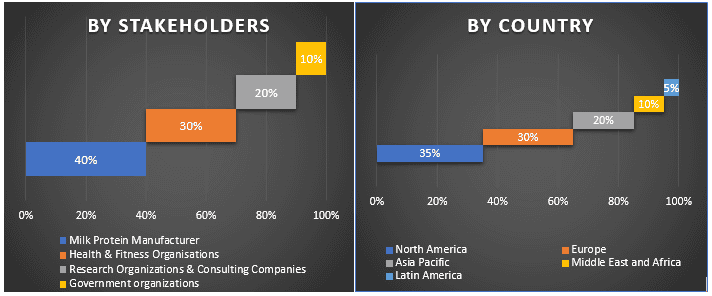
Market Engineering
Data triangulation technique was employed to complete the overall market estimation and to arrive at precise statistical numbers of each segment and sub-segment of the Milk Protein market. Data was split into several segments & sub-segments post studying various parameters and trends in the areas of Type, Form, Nature, Application, and livestock of the Milk Protein market.
Main Objective of the Milk Protein Market Study
The current & future market trends of Milk Protein were pinpointed in the study. Investors can gain strategic insights to base their discretion for investments from the qualitative and quantitative analysis performed in the study. Current and future market trends were determined the overall attractiveness of the market at a regional level, providing a platform for the industrial participant to exploit the untapped market to benefit as a first-mover advantage. Other quantitative goals of the studies include:
- Analyze the current and forecast market size of Milk Protein in terms of value (US$). Also, analyze the current and forecast market size of different segments and sub-segments
- Segments in the study include areas of application, form, packaging type, distribution channel, ingredients, and end-user
- Define and analysis of the regulatory framework for the Milk Protein industry
- Analyze the value chain involved with the presence of various intermediaries, along with analyzing customer and competitor behaviors of the industry
- Analyze the current and forecast market size of the Milk Protein market for the major countries
- The major region studied in the report includes North America, Europe, Asia- Pacific and Rest of the World.
- Company profiles of the Milk Protein market and the growth strategies adopted by the market players to sustain in the fast-growing market
Deep dive regional level analysis of the industry
Related Reports
Customers who bought this item also bought




